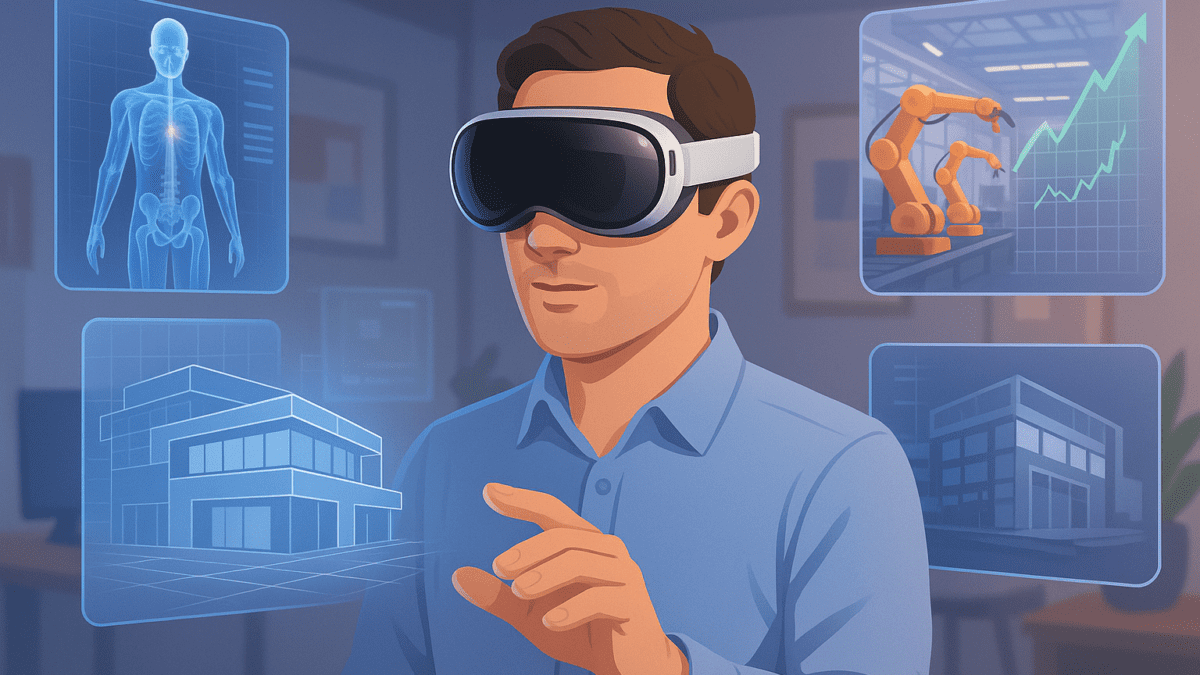Spatial Computing in 2025: How Apple Vision Pro and AR Are Reshaping Industries
Table of Contents
In 2025, spatial computing is no longer a buzzword—it’s becoming a mainstream technology. With Apple Vision Pro leading the charge, augmented reality (AR), virtual reality (VR), and mixed reality (MR) are merging into powerful platforms that transform how we work, shop, learn, and interact.
Spatial computing refers to technology that blends the physical and digital worlds, allowing people to interact with data, environments, and content in immersive 3D spaces. For businesses, it’s more than futuristic—it’s becoming a competitive necessity.
Apple Vision Pro: The Catalyst for Change
Launched in early 2024, Apple Vision Pro set a new benchmark for AR/VR headsets with its:
- Ultra-high resolution displays
- Eye-tracking and hand-gesture controls
- Seamless integration with Apple’s ecosystem
- Mixed reality features for both immersive and “blended” experiences
Unlike earlier headsets, Apple Vision Pro positioned spatial computing not as gaming-only, but as a productivity, collaboration, and lifestyle tool—pushing industries to rethink applications.
Key Industries Reshaped by Spatial Computing
1. Healthcare
Spatial computing is revolutionizing medicine by enabling:
- AR-assisted surgeries: Surgeons can overlay patient scans in real-time during procedures.
- Medical training: Students practice in immersive 3D simulations.
- Remote consultations: Patients interact with doctors in virtual clinics.
💡 Example: AR platforms now allow orthopedic surgeons to visualize bone structures during operations, reducing errors and improving precision.
2. Education & Training
Spatial computing creates immersive classrooms where students explore history, science, or complex engineering in interactive 3D spaces.
- Teachers use Vision Pro to create “field trips” without leaving the classroom.
- Enterprises train employees in lifelike simulations—safer and more cost-effective than physical setups.
3. Retail & E-Commerce
Brands are adopting AR to let customers:
- Virtually try on clothes, eyewear, or makeup.
- Visualize furniture in their homes before buying.
- Experience immersive product demos that boost engagement and sales.
💡 Example: IKEA’s AR app now integrates with Apple Vision Pro, letting users walk around a lifelike 3D model of their living room with furniture placed in real time.
4. Architecture & Real Estate
Spatial computing allows architects, engineers, and buyers to:
- Walk through digital twins of buildings before they’re built.
- Make real-time design changes in immersive environments.
- Showcase properties to buyers remotely through VR tours.
This not only reduces costs but also accelerates project approvals.
5. Entertainment & Media
The entertainment industry is leading early adoption:
- Immersive films and concerts are being produced for AR/VR experiences.
- Gaming companies are creating titles that blend real-world environments with digital overlays.
- Sports fans can watch games from “virtual stadium seats” anywhere in the world.
The Business Benefits of Spatial Computing
- Enhanced Customer Experience: Immersive engagement increases brand loyalty.
- Operational Efficiency: Training, design, and simulations reduce costs and errors.
- Competitive Advantage: Early adopters stand out in crowded markets.
- New Revenue Models: From virtual product launches to subscription-based AR platforms.
Challenges Ahead
Despite the hype, businesses face obstacles:
- High Costs: Apple Vision Pro starts at a premium price, limiting accessibility.
- Hardware Adoption: Mass consumer adoption may take years.
- Content Creation: Developing AR/VR content requires new skills and tools.
- Ethical & Privacy Concerns: Tracking eye movements and user environments raises data privacy issues.
The Future of Spatial Computing
Looking ahead, spatial computing is set to:
- Blend AI + AR: AI-generated environments will personalize user experiences.
- Expand Access: As devices become cheaper, adoption will spread across SMEs and consumers.
- Integrate Across Devices: Smartphones, wearables, and headsets will merge into one ecosystem.
- Define the Metaverse: Unlike hype-driven “metaverse” projects, spatial computing offers practical, real-world applications.
Conclusion
Spatial computing in 2025 is more than a tech trend—it’s an industry revolution. With Apple Vision Pro at the forefront, businesses in healthcare, education, retail, real estate, and entertainment are reimagining what’s possible.
The winners of this new era will be companies that embrace spatial computing early, experiment boldly, and build immersive experiences that combine the best of the digital and physical worlds.
You May Also Like:The Creator Economy 3.0: How AI Influencers Are Redefining Marketing





